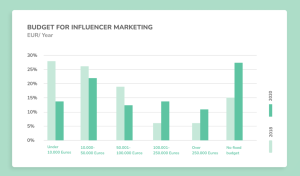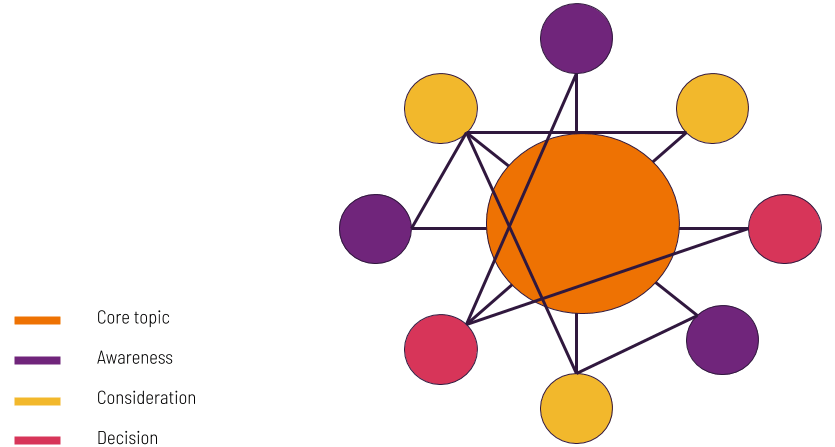Influencer marketing is becoming one of the most talked-about marketing strategies. Brands are increasingly turning to influencers to drive brand awareness and source unique content. But why is it so popular? And how can you create an effective influencer marketing strategy? This post aims to answer both of these questions. So let’s get started!
Why are so many brands using influencer marketing?

93% of brands are using influencer marketing. Here, are some of the reasons so many brands are taking to influencers to promote their products:
- Cost-effective – Compared to professional photo shoots, influencer content is estimated to be around 24% cheaper according to AspireIQ findings.
- No ad blockers – Traditional banner ads have become pretty ineffective. One reason is that so many people now run ad blockers. Influencers don’t have this problem to bypass.
- Trust – according to Nielsen data, 92% of consumers trust recommendations from influencers.
- Purchase intent – SproutSocial found that 74% of consumers use social media to make purchasing decisions.
- High engagement – Instagram has the highest average engagement of the major social media platforms, average around 2,000 engagements per post.
- Marketing ROI – higher than traditional digital marketing campaigns with AspireIQ stating that the average campaign ROI is 432%.
The numbers paint a clear picture: influencer marketing is becoming the go-to choice for an increasing number of marketers. Not only this, but it’s one of the most effective marketing channels.
Table of Contents
ToggleWhat do brands use influencer marketing for?

Brands primarily use influencer marketing for brand promotion. But an increasing number of marketers are turning to influencers for content creation. This is interesting because influencer marketing has become a driving force in the world of content marketing: AspireIQ found that 79.2% of brands use influencer marketing for brand promotion and 61.9% for content creation. If it’s not already, you need to make influencer marketing an integral part of your marketing campaigns.
1. Define your objectives with KPIs

The foundation of any great marketing strategy is clearly defined goals, and influencer marketing is no exception. Your first step should be to define the type of campaign: exposure, brand awareness, feedback, or direct sales. Related: What Are the Best Content Marketing KPIs to Use?
2. Find the right influencers for your brand

Nowadays, it’s easier than ever before to find the right influencers for your brand. There are many dedicated platforms such as AspireIQ or Upfluence that can help you in this process. Using a platform will save you a lot of time and hassle.
3. Aim to build lasting relationships

Once you have found your perfect influencer, cultivate the relationship. Over time, they will be a valuable brand advocate. After you have run a couple of campaigns, it will take less work to execute as you will both understand each other’s brands and your needs. As you establish a mutually beneficial relationship, you may well be able to negotiate a better price too.
4. Focus on micro-influencers

Wait, why? Surely, influencers with more reach are better for your brand? Actually no! Surprisingly, the data suggests that micro-influencers achieve higher engagement rates than celebrity influencers. According to a study by AspireIQ, micro-influencers with between 4,000 and 10,000 followers achieve the highest engagement rates at an average of 4.34%. The engagement was found to drop with follower count, and above 250,000 followers it stays around 2%. For your brand, this is a win-win. Influencers with fewer followers typically command a lower price (cost per engagement) than celebrity influencers.
How much does influencer marketing cost?

Influencer marketing is much cheaper than traditional CPC (Cost per Click) advertising. According to WordStream, the average CPC is around $1-2 but AspireIQ data puts the average cost per engagement (CPE) at just $0.26 on Instagram. So what factors affect the CPE? Brands look at the following factors when considering CPE pricing:
- Number of followers – typically the more followers the higher the CPE.
- Engagement vs reach – brands look for high average engagement rates.
- Quality of content – it’s important to check the quality of the content influencers are producing.
- Specific post requirements – for some campaigns, you may have a specific type of influencer or even an individual in mind.
One more thing to bear in mind. AspireIQ found that influencers typically do not accept free products as payment. It’s best to stick to well-established CPEs.
How to measure influencer marketing ROI

One way to measure influencer marketing ROI is to use the concept of earned media value. You can assign a theoretical dollar value to each type of engagement or interaction. Once you have added up this value, you can simply compare it to how much you spent on the campaign to calculate your ROI. Influencer marketing platform AspireIQ suggested the following values:
- $0.003 for Potential impressions (This is simply the number of people who could possibly see your content – On Instagram this would be the influencer’s number of followers)
- $0.05 for views
- $0.15 for likes
- $1.00 for comments
- $3.00 for clicks
AspireIQ found that on average, brands spend $6,249.81 per campaign, and using the above formula, earn a media value of $26,986.77. Impressively, this amounts to an average campaign ROI of 432%! No wonder that so many brands are turning to influencer marketing. Note: You can, of course, adjust these numbers to meet your needs. You may run influencer campaigns where you are specifically aiming to maximize another metric such as likes. In this case, you can adjust the numbers to create your own unique earned media value metric.
Get started with influencer marketing today

Influencer marketing is taking over the world of marketing. Hopefully, our guide will help you get up and running quickly with an effective influencer marketing campaign. This emerging marketing channel is becoming a key battleground for driving brand awareness and sourcing unique content. Have you completed your first influencer marketing campaign? What were the results? Let us know in the comments below.









